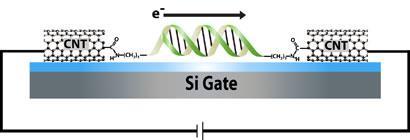Epigenetic modification of DNA can be spotted by measuring changes in its conductance
US chemists have developed a way to detect the chemical modification of a single strand of DNA, by hooking it up to a pair of carbon nanotubes (CNTs).
Chemical modification of DNA, especially the addition of a methyl group to the base cytosine, is one of the main mechanisms by which cells switch genes on and off. Over the past few years, scientists have come to realise that such modifications can be passed down through generations, offering a way for limited traits acquired during a lifetime to be inherited and launching the field of epigenetics.
The challenge now is to develop techniques sensitive enough to detect the chemical modification of individual genes. This is what a team of US chemists jointly led by Jacqueline Barton at the California Institute of Technology in Pasadena and Colin Nuckolls at Columbia University in New York has now come up with for DNA methylation.
Their technique involves taking a single wall CNT and etching a gap in the middle of it. They then deposit a single strand of DNA in the gap and attach it to the two CNT sections, before hooking the whole thing up to an electric current.

Ordinarily, current passes easily through the DNA-CNT wire, but that can change when the wire is exposed to the enzyme methyltransferase. If the DNA strand contains a cytosine base within an appropriate binding site, then the methyltransferase binds to the strand and attaches a methyl group to the cytosine base. This involves the enzyme ’flipping out’ the cytosine base from the DNA strand, essentially shorting the DNA-CNT wire and causing the electrical conductivity to fall by over 90 per cent.
By monitoring the current flowing through the DNA-CNT wire, the team found that they could detect when a methyl group had been added to the DNA strand. Using DNA strands that lacked a cytosine base in an appropriate binding site, they also showed that this fall in conductivity only occurred for DNA methylation. Following this success, they are now looking to extend the technique to detect other types of DNA modification.
Chris Schofield leads a team at Oxford University, UK, studying the chemical basis of epigenetics and says that this technique could come in very handy. ’It appears to be a very promising approach to identifying modifications to DNA, which is a topic with huge biological importance in the field of epigenetics,’ he tells Chemistry World.
Jon Evans
References
H Wang et al, Chem. Sci., 2011, DOI: 10.1039/<man>c1sc00772f</man>






No comments yet